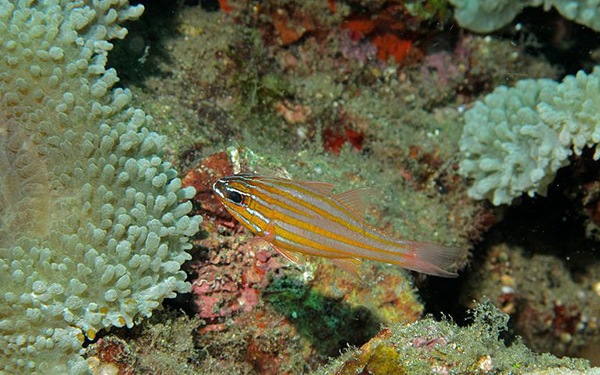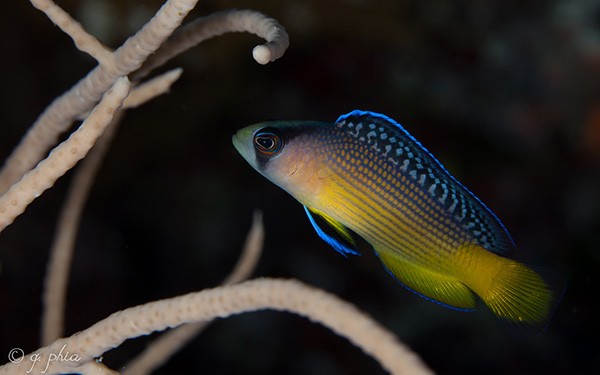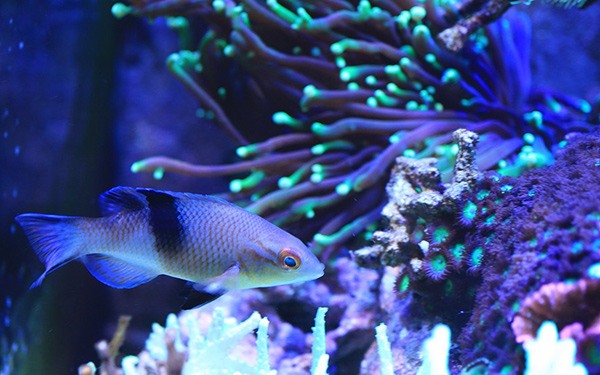Want to know the best saltwater fish for beginners? We’ve got you covered.
Building and curating a thriving saltwater aquarium is often the ultimate aim for any fish enthusiast.
The bright colors and magical beauty of saltwater fish provides endless fun for all ages.
So how can you build your own saltwater aquarium?
With a healthy dose of patience and determination and the guidance of this article, you shall be well equipped to start your very own underwater kingdom.
Let’s take it away….
What are Saltwater Fish?
The water in the world’s oceans, lakes and rivers are not all the same.
There are two broad categories of water: freshwater and saltwater.
Saltwater has a higher salinity content than freshwater, about 3.5% compared to freshwater’s 0.1%.
This means that any marine life living in saltwater would need considerable adaptation to survive and thrive.
Saltwater Fish vs Freshwater Fish
The main physiological difference between saltwater and freshwater fish is their levels of salt concentration: this feature is referred to as osmoregulation.
Essentially, the body tissue in saltwater fish contains less salt than the water it lives in. This mean that the water around the fish draws on the water in the fish’s body which leads to constant water loss.
Saltwater fish tackle this high risk of dehydration by drinking considerable amounts of saltwater and producing only a small amount of salty urine.
On the other hand, freshwater fish have much higher salt concentration in their bodies compared to their environment.
This is what drives the opinion that freshwater fish are easier to maintain than saltwater fish as they require much less physiological adaptation.
Moreover, freshwater fish are generally far hardier and more resistant than their salty counterparts, as only 2.5% of the earth’s water is freshwater which has forced the freshwater fish to become much more adaptable to their environment.
Saltwater fish, on the other hand, enjoy the luxury of more stable marine environment, which is why the constant monitoring of your own Saltwater aquarium is crucial for its success.
Whilst freshwater fish can either be cold-water or tropical fish, saltwater fish are all cold-water fish.
Some of the most famous examples are clownfish (Nemo, anyone?) seahorses and eels.
How to Care for Saltwater Fish
As you can see, it is extremely important to maintain a stable environment for your saltwater fish and be prepared to spend more to achieve this.
According to FishLore, the average price to set up a saltwater aquarium (without the fish) is approximately $635.00 compared to $270.00 for a freshwater aquarium.
Before curating your own saltwater fish tank you will need to decide what kind of environment you want to recreate in your aquarium.
You could have a fish only tank, or maybe even a single species tank or if you’d rather more variety, then a coral reef system could work for you.
A word of warning: a coral reef system is the most demanding option, requiring very specific lighting and water flow. We would warn against this for beginners.
You should keep in mind the size of tank you want to get, as the larger tanks tend to handle water fluctuations much better than their smaller counterparts.
As for the ideal temperature of your saltwater aquarium, unfortunately there is no straightforward answer.
Successful aquariums tend to hit somewhere between 75-80 degrees, with some coral systems thriving in temperatures as high as 85 degrees.
Keep in mind that saltwater fish can come from any of the world’s oceans, so a temperature that suits saltwater fish in the Atlantic will clash with temperatures that suit fish from the central Indo-Pacific. This should be something that you keep in mind as you consider the sort of fish you would like in your tank.
Similarly, the pH level of a saltwater aquarium could vary enormously.
While a fish-only community can tolerate fluctuating pH levels, between 7.6 and 8.4, a reef community requires stricter adherence. They will need the pH level to remain constantly in the right range just to survive. This should fall between 8.0 to 8.4.
Here’s a great video about how to set up a saltwater aquarium:
Also keep in mind where you will keep your aquarium. You may think that you’ve found the perfect spot in front of your lounge window, but think again. Sunlight exposure can cause a lot of water fluctuation problems as well as algae issues.
Saltwater aquariums also weigh a lot. The water itself is heavy at about 8.5 lb/gal, add on top of that the live rock, substrate, pumps and lighting, your aquarium is going to become very heavy very quickly. Choose a location carefully!
The Best Beginner Saltwater Fish
Royal Gramma

Sometimes known as the ‘fairy basslet’, these electric purple and yellow fish will fit easily into your aquarium.
They are small, growing up to 3 inches in length, and peaceful in nature.
Typically, they will live between 3 to 5 years.
Originating from the Caribbean, these fish like to like in 72-78 degree water with a pH level between 8-8.4.
These little guys will need a minimum tank size of 30 gallons and could live alone, in a pair or in a community aquarium. They will munch on flake, pellet, meat and frozen foods.
The Royal Gramma’s versatility and beautiful coloring make for a perfect beginner saltwater fish.
Firefish
As its name suggests, these fantastic and unusually shaped fish make for an interesting addition to your aquarium.
However, they do not possess fiery personalities and are, in fact, shy and timid.
You will need to buy lots of rock features and hidey-holes for these little guys to hide in just in case they get stressed.
Growing up to 3 inches in length, the Firefish need a minimum tank size of 20 gallons, with moderate lighting conditions and currents.
Also watch out, these little guys have been known to jump so make sure your tank has a securely fitted lid.
The Firefish are carnivores, so make sure to stock up on some meat to feed these fish!
Snowflake Eel

If you fancy something a little different than a normal fish, the Snowflake Moray Eel could be the perfect option for you. These cool guys are incredibly easy to maintain with chilled out personalities and docile behavior.
Like the Firefish, the Snowflake eel can be known to be sneaky by finding ways to escape their tank, so make sure your lid stays firmly on!
Typically growing to 28 inches you’ll need a larger tank with lots of rocky areas to accommodate your eel, we advise a minimum tank size of 75 gallons (don’t forget the secure hood).
Keep your tank between 72-78 degrees and between 8.1 and 8.4 pH to create the perfect environment for your eel.
Also, these guys love to snack on meaty and live food – so they’re maybe not the perfect option for the squeamish!
Snowflake Eels are best kept singly, with invertebrates and large, aggressive fish. But be sure to keep them away from crustaceans!
Ocellaris Clownfish

For any lover of Finding Nemo, the Ocellaris Clownfish is sure to be a big hit.
The spitting image of its cartoon cousin, the Ocellaris Clownfish are peaceful and easy to care for. They are very adaptable, and can live in a community tank, although be aware, they may be aggressive towards other clownfish.
Growing up to 4 inches, these guys will eat flake, pellet, meat and frozen food.
The perfect tank will be 30 gallons and kept between 73 and 78 degrees and 8-8.4 pH.
Squirrelfish

The squirrelfish are quite distinct from other saltwater fish. Their large googly eyes and clicking noise they make as they swim are sure to fascinate those who view your aquarium.
They can grow as big as 8 inches and are easy to care for with peaceful personalities. Keep them in a small group, and they can live with other mild predators.
These guys will eat live, freeze dried and meaty food.
Make sure your tank (minimum 70 gallons) has lots of live rock and strong water circulation as this will create the best environment for them to live in.
You’ll want to monitor your tank and keep it between 72 and 78 degrees and 8.1 and 8.4 pH.
Black Cap Basslet

The Black Cap Basslet looks different to the Royal Gramma. Bright purple with a distinguishable black cap, these guys are relatively peaceful but can be aggressive towards other basslets.
It’s best to keep them either singly or with similarly sized fish.
They will eat pellets and meaty food. Be sure to keep them in a tank no smaller than 30 gallons, kept between 72 and 80 degrees and between 8.1 and 8.4 pH, and decorated with lots of live rock.
Yellow Striped Cardinalfish

A popular choice among beginner aquarists, the Yellow Striped Cardinalfish is a clam and colourful option for your aquarium, growing up to a tiny 2.5 inches!
These little guys enjoy a game of hide and seek when they’re feeling shy, so decorating your tank with lots of sea grass is ideal.
You should keep your tank (minimum 10 gallons) between 72 and 78 degrees and between 8.1 and 8.4 pH.
The Cardinalfish love to eat live, pellet and meaty food.
Be sure to keep these dudes in a pair, small groups or with other peaceful saltfish, otherwise they could get lonely.
Klein’s Butterflyfish
The Butterflyfish variety are usually pretty tricky for beginner aquarists, but Klein’s Butterflyfish is much easier to care for.
These peaceful omnivores are best kept in a fish only tank.
They will need a large tank, with a minimum size of 120 gallons.
Chalk Bass

The Chalk Bass are a hardy variety of bass and are usually peaceful. Make sure your tank has lots of rock and cave areas for the Chalk Bass to explore and hide in.
So long as they’re introduced at the same time these guys can hang out with others of their own kind and can thrive with many different community fish.
Make sure your tank hold a minimum of 30 gallons of water, and that its has a secure lid – they have been known to jump!
The Chalk Bass is a carnivore, so be sure to feed them plenty of meaty food.
Neon Blue Gobie

The Neon Blue Goby is the most common and popular of over 2000 species of goby saltfish.
These guys are usually peaceful in nature but have been known to be aggressive to other neon gobies if they’re not mated in a pair. If you do not keep them in a mated pair, then keeping them singly is best.
Make sure your tank is minimum 10 gallons in size, and keep it maintained between 72 and 78 degrees and 8.1 and 8.4 pH.
They will eat live, frozen and meaty foods.
Dottyback

Growing up to 3 inches, these saltwater fish are cool to look at. The Dottyback come in a variety of colors, the most vibrant of which are the Purple or Bicolor Dottybacks. They are sure to delight all audiences.
We recommend keeping them in a minimum size 30 gallon tank, the Dottyback has been known to act aggressively in small tanks. You would be wise not to underestimate these guys! Despite their small size, they can hold their own against larger fish, and in fact thrive in tanks with bigger and semi aggressive fish.
Keep your tank between 72 and 78 degrees and 8.1 and 8.4 pH to create the perfect environment for the Dottyback. Feed them with meaty food.
Yellow Tail Damselfish

The Yellow Tail Damselfish is sure to be the focus in your aquarium. Colored bright cobalt blue with a yellow tale, even though they typically only grow to 3 inches, these guys can make an impact.
They are generally peaceful in nature and are the least aggressive of the Damselfish type.
They have been known to be territorial towards other Damsels, so it’s best to keep them in odd-numbered groups amongst other non-aggressive fish.
Make sure your tank is minimum 30 gallons and keep it between 72 and 78 degrees. Maintain the tank between 8.1 and 8.4 pH to create the perfect environment for your damselfish.
Conclusion
This article has hopefully given you some useful insight and knowledge so that you can start your very own special saltwater fish aquarium.
While they are certainly harder to take care of than their freshwater counterparts, saltwater fish can thrive when careful consideration is taken with regards to the tank size, water temperature, pH level and circulation.
The fish we recommend make the perfect choices for any beginner aquarists — just be sure that the fish you select will live well with each other.
So with that, good luck with your first saltwater fish aquarium!





